初中8种时态的用法及区别
初中英语八大时态结构及用法详解
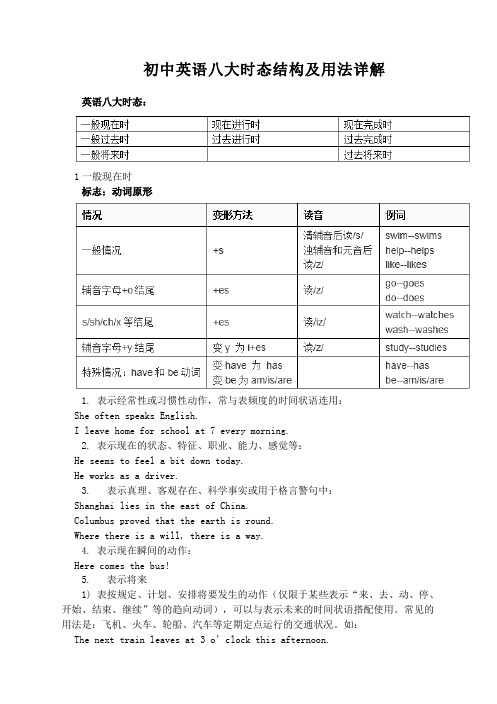
初中英语八大时态结构及用法详解英语八大时态:1一般现在时标志:动词原形1. 表示经常性或习惯性动作,常与表频度的时间状语连用:She often speaks English.I leave home for school at 7 every morning.2. 表示现在的状态、特征、职业、能力、感觉等:He seems to feel a bit down today.He works as a driver.3. 表示真理、客观存在、科学事实或用于格言警句中:Shanghai lies in the east of China.Columbus proved that the earth is round.Where there is a will, there is a way.4. 表示现在瞬间的动作:Here comes the bus!5. 表示将来1) 表按规定、计划、安排将要发生的动作(仅限于某些表示“来、去、动、停、开始、结束、继续”等的趋向动词),可以与表示未来的时间状语搭配使用。
常见的用法是:飞机、火车、轮船、汽车等定期定点运行的交通状况。
如:The next train leaves at 3 o’clock this afternoon.How often does the shuttle bus run?2) 在时间和条件状语从句中常使用一般现在时表示将来发生的事情:When Bill comes (不用will come), ask him to wait for me.I shall go there tomorrow unless I’m too busy.2一般过去时标志:动词过去式*闭音节:元音字母a, e, i, o, u如果发字母本来的音则称为开音节,否则称为闭音节。
1. 表示过去某时所发生的动作或存在的状态,常与表示过去的时间状语连用(e.g. yesterday, this morning, just now, a moment ago, in May, last night / year / week, once upon a time, the other day, before …, when …, in the past等)。
英语中常见的八大时态(结构及用法)
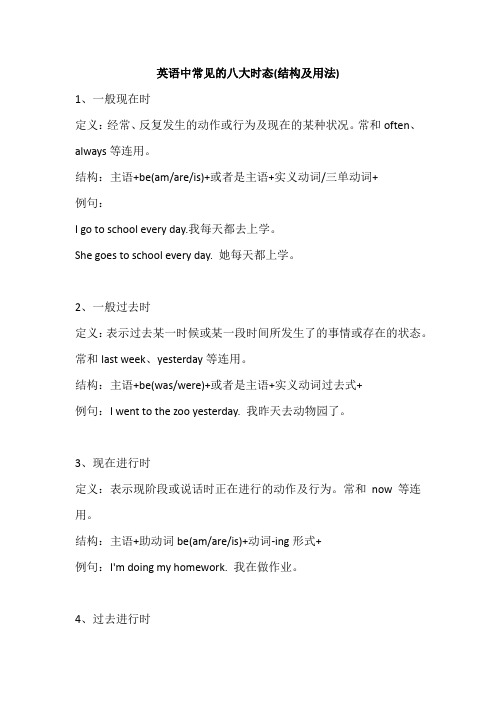
英语中常见的八大时态(结构及用法)1、一般现在时定义:经常、反复发生的动作或行为及现在的某种状况。
常和often、always等连用。
结构:主语+be(am/are/is)+或者是主语+实义动词/三单动词+例句:I go to school every day.我每天都去上学。
She goes to school every day. 她每天都上学。
2、一般过去时定义:表示过去某一时候或某一段时间所发生了的事情或存在的状态。
常和last week、yesterday等连用。
结构:主语+be(was/were)+或者是主语+实义动词过去式+例句:I went to the zoo yesterday. 我昨天去动物园了。
3、现在进行时定义:表示现阶段或说话时正在进行的动作及行为。
常和now等连用。
结构:主语+助动词be(am/are/is)+动词-ing形式+例句:I'm doing my homework. 我在做作业。
4、过去进行时定义:表示在过去某个时间点发生或进行的行为的事情。
常和at this time yesterday等或以when引导的谓语动词连用。
结构:主语+助动词be(was/were)+动词-ing形式+例句:When I got to the top of the mountain, the sun was shining. 我到达山顶时,阳光灿烂。
5、现在完成时定义:表示过去发生的动作对现在造成的影响或结果或过去的动作或状态持续到现在。
构成:主语+助动词(have/has)+动词过去分词+例句:I have lived here for more than twenty years. 我住在这儿二十多年了。
6、过去完成时定义:表示在过去某一时刻或动作以前完成了的动作,也可以说过去的时间关于过去的动作。
构成:主语+助动词(have/has)+动词过去分词+例句:She said she had never been to Paris. 她告诉我她曾去过巴黎。
初中英语八大时态结构及用法
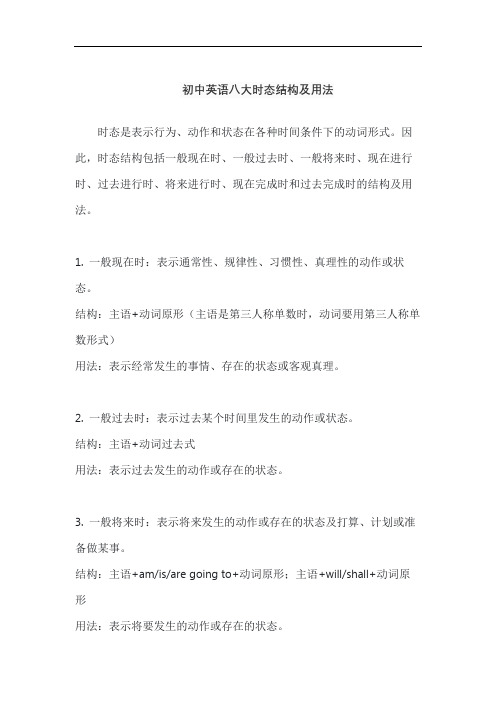
初中英语八大时态结构及用法时态是表示行为、动作和状态在各种时间条件下的动词形式。
因此,时态结构包括一般现在时、一般过去时、一般将来时、现在进行时、过去进行时、将来进行时、现在完成时和过去完成时的结构及用法。
1. 一般现在时:表示通常性、规律性、习惯性、真理性的动作或状态。
结构:主语+动词原形(主语是第三人称单数时,动词要用第三人称单数形式)用法:表示经常发生的事情、存在的状态或客观真理。
2. 一般过去时:表示过去某个时间里发生的动作或状态。
结构:主语+动词过去式用法:表示过去发生的动作或存在的状态。
3. 一般将来时:表示将来发生的动作或存在的状态及打算、计划或准备做某事。
结构:主语+am/is/are going to+动词原形;主语+will/shall+动词原形用法:表示将要发生的动作或存在的状态。
4. 现在进行时:表示现阶段或说话时正在进行的动作及行为。
结构:主语+am/is/are+现在分词用法:表示正在进行的动作。
5. 过去进行时:表示过去某段时间或某一时刻正在发生或进行的动作或行为。
结构:主语+was/were+现在分词用法:表示过去正在进行的动作。
6. 将来进行时:表示将来某一时刻正在进行的动作,或表示要在将来某一时刻开始,并继续下去的动作。
结构:主语+shall/will+be+现在分词用法:表示将来正在进行的动作。
7. 现在完成时:表示过去发生的动作对现在造成的影响或结果,或表示过去的动作或状态持续到现在。
结构:主语+have/has+过去分词用法:表示已经完成的动作或存在的状态。
8. 过去完成时:表示在过去某一时刻或动作以前已经完成了的动作或存在的状态。
结构:主语+had+过去分词用法:表示过去已经完成的动作。
英语中八种时态的具体用法

英语中八种时态的具体用法(1)一般现在时表示现阶段经常或习惯发生的动作或存在的状态,或说明主语的特征。
①一般现在时句子中常有的时间状语:often,usually,sometimes,always,every(day等),once/twice,a (week等), on (Sunday等),never,in the(morning等)。
如:They go to the Palace Museumonce a year.(他们每年去一次故宫)/ They oftendiscuss business in the evening.(他们经常在晚上商谈生意)②表示客观真理、事实、人的技能或现在的状态时句子里一般不用时间状语。
如:The earth turns round thesun.(地球绕着太阳转)/ Light travels faster thansound.(光传播比声音快)③表示十分确定会发生(如安排好的事情)或按照时间表进展的事情,用一般现在可以表达将来,句子中可以有将来时间。
如:The train for Haikou leaves at 8:00 in themorning.(开往汉口的列车上午8点开车)④在时间状语从句中(以when, after, before, while, until,as soon as等引导)与条件状语从句中(以if,unless引导),用一般现在时代替一般将来时,句子可以有将来时间。
如:Please ring me up as soon as you arrive inGermany.(你一到德国就给我打)/ If it rainstomorrow,we will have to stay at home.(如果明天下雨我们就只好呆在家)⑤一般现在时用于倒装句中可以表示正在发生的动作,动词以come, go为主。
如:Here comes the bus. (车来了)/ There goes the bell.(铃响了)。
初中英语必考-八大时态结构及用法详解
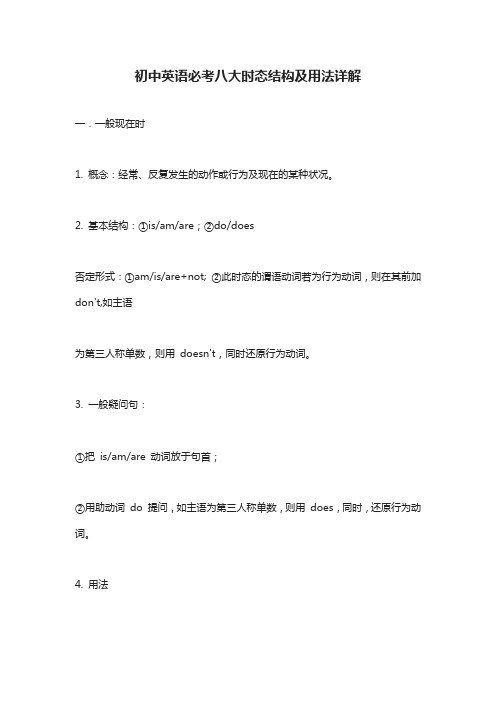
初中英语必考八大时态结构及用法详解一.一般现在时1. 概念:经常、反复发生的动作或行为及现在的某种状况。
2. 基本结构:①is/am/are;②do/does否定形式:①am/is/are+not; ②此时态的谓语动词若为行为动词,则在其前加don't,如主语为第三人称单数,则用doesn't,同时还原行为动词。
3. 一般疑问句:①把is/am/are 动词放于句首;②用助动词do 提问,如主语为第三人称单数,则用does,同时,还原行为动词。
4. 用法1)经常性或习惯性的动作,常与表示频度的时间状语连用。
例如:I leave home for school at 7 every morning. 每天早上我七点离开家。
2)客观真理,客观存在,科学事实。
例如:The earth moves around the sun. 地球绕太阳转动。
Shanghai lies in the east ofChina. 上海位于中国东部。
3)表示格言或警句。
例如:Pride goes before a fall 骄者必败。
注意:此用法如果出现在宾语从句中,即使主句是过去时,从句谓语也要用一般现在时。
例如:Columbus proved that the earth is round. 哥伦布证实了地球是圆的。
4)现在时刻的状态、能力、性格、个性。
例如:I don't want so much. 我不要那么多。
Ann writes good English but does not speak well.安英语写得不错,讲的可不行。
5)一般现在时表示将来含义。
a. 下列动词come, go, arrive, leave, start, begin, return 的一般现在时可以表示将来,主要用来表示在时间上已确定或安排好的事情。
例如:The train leaves at six tomorrow morning. 火车明天上午六点开。
初中英语八种时态

– 4. 形式 肯定句 否定句 疑问句 I am studying. I am not studying. Am I studying? am/ No,I am not.
简要回答 Yes,I
• 5. 一般现在时和现在进行时的区别 (1) 一般现在时表示经常性或习惯性的动作,现 在进行时表示正在发生的行为。 • a. He is cleaning his room now.他在打扫房间。 • He cleans his room every day.他每天都要打扫房 间。 • b.They are visiting China.他们正在中国观光。 • They often come to China for a visit.他们经常来 中国观光。 • (2) 一般现在时表示现在的状态。 • He likes jiaozi. They have a lot of friends
•
二、现在进行时( present continuous tense) 1.构成 be(am/is/are)+动词的现在分 词
• 2.用法 • a. 表示现在正在进行或发生的动作。 He is eating an ice cream.他正在吃冰激凌。 • Let’s wait. The children are crossing the street. • b. 表示当前一段时期内的活动或现阶段正在进行的动作(说话时不一 定正在进行)。 We are working on a farm these days? 这些天我们在一个农场干活。 c. 表示位置移动或趋向的词,如go,come, start,leave, arrive, move等常用进行时表将来。 He is leaving for Shanghai tomorrow. I'm coming! What's the score now? 我就来!现在比分是多少? • We are moving to a big house next month. 下个月我们将搬到一所大 房子里。 • d. 与always, constantly, forever 等词连用,表示反复发生的动作或持 续存在的状态,往往带有说话人的主观色彩。 You are always changing your mind.
8个初中英语时态

8个初中英语时态8个初中英语时态是学习英语语法的重要组成部分,以下是它们的定义和例句:1. 现在一般时态:表示现在的动作或状态。
例如:I eat an apple every day. (我每天吃一个苹果。
)2. 过去一般时态:表示过去的动作或状态。
例如:She studied English last year. (她去年学了英语。
)3. 现在进行时态:表示正在进行的动作或状态。
例如:He is watching TV now. (他正在看电视。
)4. 过去进行时态:表示过去某个时间正在进行的动作或状态。
例如:They were having dinner when I called. (我打电话的时候他们正在吃饭。
)5. 现在完成时态:表示已经完成的动作或状态,强调对现在的影响。
例如:I have learned English for three years. (我已经学了三年英语了。
)6. 过去完成时态:表示过去某个时间之前已经完成的动作或状态。
例如:They had finished their homework by the time I arrived. (我到的时候他们已经完成作业了。
)7. 现在完成进行时态:表示从过去开始一直持续到现在的动作或状态,强调对现在的影响。
例如:He has been studying English for five years. (他已经学了五年英语了。
)8. 过去完成进行时态:表示从过去某个时间开始一直持续到过去的动作或状态。
例如:They had been waiting for the bus for an hour when I arrived. (我到的时候他们已经等了一个小时的车了。
)。
【初中】英语八大时态详细汇总

现在完成时意义:He has lived here for many years.2.强调后果/影响I have read the book .结构:时间状语:(1)since 的用法Since+时间点I have lived here since 2022.一段时间+ago I have lived here since two years ago.+从句(用一般过去时)常见句型:It is + 一段时间+since从句主句(完成时)+since(一般过去时)It is seven years since I met him last time.He has learned 2000 words since he went to school.(2)For+时间段We have known each other for five years.(3)already(用于肯定句中)/yet (用与否定句或疑问句中)just/everrecently( in recent years)before never等(just now是一般过去时的时间状语)I have just finished my homework.Have you ever seen one like this?(4So far /in the past few years等,表示:“目前为止”非延续性动词延续性动词非延续性动词延续性动词Borrow Keep Fall asleep Be asleep buy have Catch a cold Have a cold leave Be away Begin/start Be ondie Be dead open Be open Come (to)Be in/at close Be closed区分Have gone to去了没回Have been to去了回来(常与次数once/twice/基数词+times连用)Have been in在某地呆了多久例句:(1)You can’t see her because he has gone to Sibo.(2)He has been to Sibo twice.(3)He has been in this city for two years.备注:Here/there/home 不与介词连用。
初中8大时态用法及用法

初中8大时态用法及用法初中阶段的英语学习主要涉及到过去时态、现在时态以及将来时态等基础时态。
以下是这些时态的一些基本用法:1. 现在时态(Simple Present)- 表示经常性、习惯性的动作或状态:I play tennis every Saturday.(我每个星期六打网球。
)- 表示客观事实、永恒性真理:The sun rises in the east.(太阳从东方升起。
)- 表示主观感受、经验或喜好:I enjoy watching movies.(我喜欢看电影。
)2. 过去时态(Simple Past)- 表示过去某个时间发生的动作或状态:I visited my grandparents last weekend.(上个周末我去看望了我的祖父母。
)- 表示过去的经常性动作或状态:She always watched TV in the evenings when she was a child.(她小时候总是在晚上看电视。
)3. 将来时态(Simple Future)- 表示将来会发生的动作或状态:I will go to the movie theater tomorrow.(明天我会去电影院。
)- 表示计划、打算或意图:I am going to study hard for the exam.(我打算为考试努力学习。
)4. 现在进行时态(Present Continuous)- 表示正在进行的动作:We are having dinner right now.(我们正在吃晚餐。
)- 表示按计划、安排即将发生的动作:I am meeting my friends for lunch tomorrow.(明天我要和朋友们吃午饭。
)5. 过去进行时态(Past Continuous)- 表示过去某个时间正在进行的动作:I was studying when he called.(他打电话的时候我正在学习。
初中英语八种时态讲解最新优质ppt课件
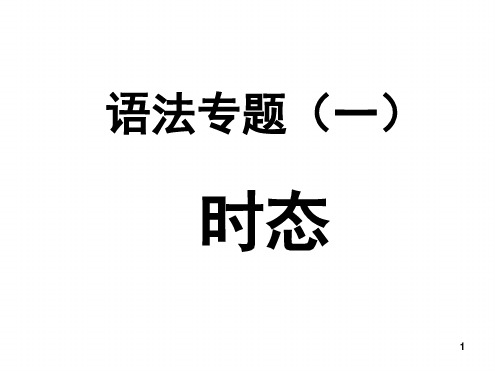
时态
1
一般现在时 一般过去时 现在进行时 过去进行时 现在完成时 过去完成时 一般将来时 过去将来时 2
一般现在时
3
一、一般现在时:
概念:经常、反复发生的动作或行为及现
在的某种状况。
时间状语:
always, usually, often, sometimes, every
(day, year, month…), once a week, on Sun
10
are) free tomorrow.
10.I will go there when I _____(have will have, has) time tomorrow. 11.He won't come to the party unle he _____(be, will be, am, is, are) invi 12.I'll wait here until my mother ____(come, comes, will come) back. 13.Please return the book to the lib as soon as you ______(finish, finishe will finish) reading it. 14.Once you _____(see, sees, will see him, you will never forget him.
stud→y studies carry→carries fly→flies
9
1. He______(be, am, is, are) a teacher at No. 2 Middle School. 2. He______(have, has) classes in the afternoon. 3.He______(get, gets) up at half past six every morning. 4.He always _____(come, comes ) to school on time. 5.He ______(study, studies) very hard at his lesson. 6. One and two _____(be, is, are) three. 7. Blue and yellow _____(make, makes) green. 8.The earth _____(move, moves) round the sun. 9.I will go there if I ____( be, will be, am, is,
初中英语语法—时态(28张) PPT课件 图文

(4)现在完成时与表示一段时间的for短语、since短语或从句等 时,应注意句中的谓语动词须是延续性的,而不能是非延续性动词,如 come→be here,go→be there,die→be dead,borrow→keep,buy→h ,join→be in,leave→be away,begin to study→study等。
6.过去进行时
(1)概念:表示过去某一时刻或某一时间段内正在进行的动作。 (2)构成形式:was/were+动词的-ing形式 ①表示往返、位移的动词的过去进行时常可用来表示过去将来时
时态 We wanted to tell her that the train was_leaving an hour later.
1.一般现在时
基本用法: (1)表示经常性、习惯性的动作; He always helps others. 他总是帮助别人。
时态 (2)表示现在的情况或状态;
He is a teacher. 他是个老师。 (3)表示客观事实和普遍真理。 The sun rises in the east. 太阳从东边升起。 构成形式:am/is/are或实义动词的原形(主语是第三人称单数时,动 词要用第三人称单数形式)。
时态 (2)构成形式:have/has+动词的过去分词。
(3)与现在完成时连用的时间状语有for a long time,recently,yet, lately,ever,never,already,since,by this time,before,just,in t past/last few years,since+过去的时间点,since+时间段+ago,since +从句(一般过去时)。
表示感觉的动词。如:see,hear等。 表示喜欢或厌恶的动词。如:like,love等。 表示希望的动词。如:want,would like等。
初中英语的八大时态

初中英语的八大时态时态无疑是学校英语最重要的语法内容,学好时态基本就拿下了语法的半壁江山。
,我在这里整理了学校英语的八大时态,盼望能关心到大家。
一般现在时一1. 概念:常常、反复发生的动作或行为及现在的某种状况。
2. 基本结构:①is/am/are;②do/does否定形式:①am/is/are+not;②此时态的谓语动词若为行为动词,则在其前加dont,如主语为第三人称单数,则用doesnt,同时还原行为动词。
3. 一般疑问句:①把is/am/are动词放于句首;②用助动词do 提问,如主语为第三人称单数,则用does,同时,还原行为动词。
4. 用法1) 常常性或习惯性的动作,常与表示频度的时间状语连用。
例如:I leave home for school at 7 every morning. 每天早上我七点离开家。
2) 客观真理,客观存在,科学事实。
例如:The earth moves around the sun. 地球绕太阳转动。
Shanghai lies in the east ofChina. 上海位于中国东部。
3) 表示格言或警句。
例如:Pride goes before a fall. 骄者必败。
留意:此用法假如消失在宾语从句中,即使主句是过去时,从句谓语也要用一般现在时。
例如:Columbus proved that the earth is round. 哥伦布证明了地球是圆的。
4) 现在时刻的状态、力量、性格、共性。
例如:I dont want so much. 我不要那么多。
Ann writes good English but does not speak well.安英语写得不错,讲的可不行。
5) 一般现在时表示将来含义a. 下列动词come, go, arrive, leave, start, begin, return的一般现在时可以表示将来,主要用来表示在时间上已确定或支配好的事情。
初中英语必考八大时态结构及用法详解
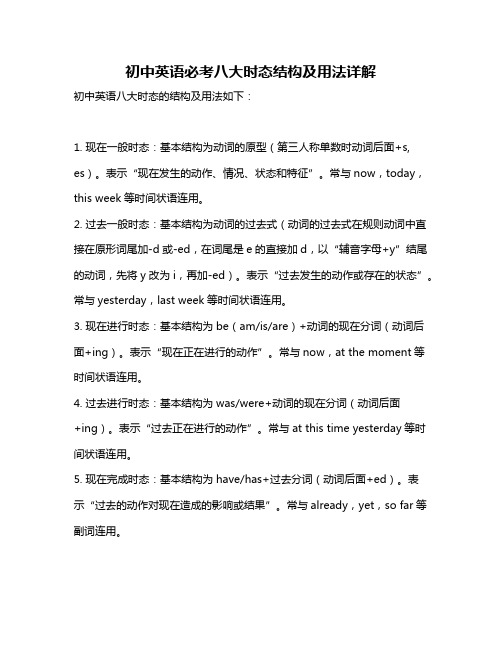
初中英语必考八大时态结构及用法详解初中英语八大时态的结构及用法如下:1. 现在一般时态:基本结构为动词的原型(第三人称单数时动词后面+s, es)。
表示“现在发生的动作、情况、状态和特征”。
常与now,today,this week等时间状语连用。
2. 过去一般时态:基本结构为动词的过去式(动词的过去式在规则动词中直接在原形词尾加-d或-ed,在词尾是e的直接加d,以“辅音字母+y”结尾的动词,先将y改为i,再加-ed)。
表示“过去发生的动作或存在的状态”。
常与yesterday,last week等时间状语连用。
3. 现在进行时态:基本结构为be(am/is/are)+动词的现在分词(动词后面+ing)。
表示“现在正在进行的动作”。
常与now,at the moment等时间状语连用。
4. 过去进行时态:基本结构为was/were+动词的现在分词(动词后面+ing)。
表示“过去正在进行的动作”。
常与at this time yesterday等时间状语连用。
5. 现在完成时态:基本结构为have/has+过去分词(动词后面+ed)。
表示“过去的动作对现在造成的影响或结果”。
常与already,yet,so far等副词连用。
6. 过去完成时态:基本结构为had+过去分词(动词后面+ed)。
表示“过去的动作在过去的某个时间之前已经完成或发生的动作或存在的状态”。
常与by the end of last year,by the time of等时间状语连用。
7. 现在完成进行时态:基本结构为have/has been+动词的现在分词(动词后面+ing)。
表示“动作从过去某时开始,一直延续到现在,或者刚刚完成”。
常与for several days,since等时间状语连用。
8. 过去完成进行时态:基本结构为had been+动词的现在分词(动词后面+ing)。
表示“过去的某个动作从过去某时开始,一直延续到过去的某个时间,或者刚刚完成”。
初中英语八大时态笔记
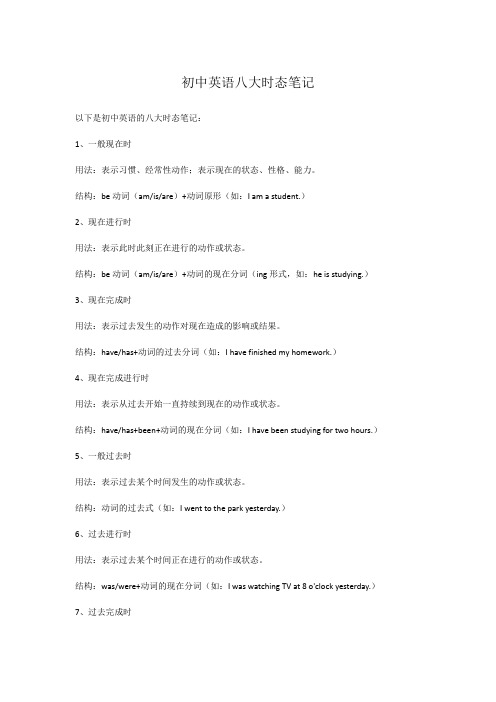
初中英语八大时态笔记以下是初中英语的八大时态笔记:1、一般现在时用法:表示习惯、经常性动作;表示现在的状态、性格、能力。
结构:be动词(am/is/are)+动词原形(如:I am a student.)2、现在进行时用法:表示此时此刻正在进行的动作或状态。
结构:be动词(am/is/are)+动词的现在分词(ing形式,如:he is studying.)3、现在完成时用法:表示过去发生的动作对现在造成的影响或结果。
结构:have/has+动词的过去分词(如:I have finished my homework.)4、现在完成进行时用法:表示从过去开始一直持续到现在的动作或状态。
结构:have/has+been+动词的现在分词(如:I have been studying for two hours.)5、一般过去时用法:表示过去某个时间发生的动作或状态。
结构:动词的过去式(如:I went to the park yesterday.)6、过去进行时用法:表示过去某个时间正在进行的动作或状态。
结构:was/were+动词的现在分词(如:I was watching TV at 8 o'clock yesterday.)7、过去完成时用法:表示在过去某个时间之前已经完成的动作或状态。
结构:had+动词的过去分词(如:I had finished my homework before dinner.)8、过去完成进行时用法:表示在过去某个时间之前一直持续到那个时间的动作或状态。
结构:had been+动词的现在分词(如:I had been studying for two hours before dinner.)。
初中英语八大时态结构及用法
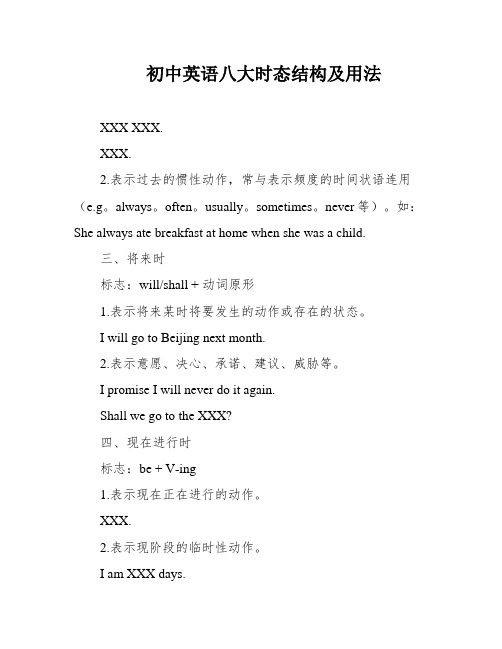
初中英语八大时态结构及用法XXX XXX.XXX.2.表示过去的惯性动作,常与表示频度的时间状语连用(e.g。
always。
often。
usually。
sometimes。
never等)。
如:She always ate breakfast at home when she was a child.三、将来时标志:will/shall + 动词原形1.表示将来某时将要发生的动作或存在的状态。
I will go to Beijing next month.2.表示意愿、决心、承诺、建议、威胁等。
I promise I will never do it again.Shall we go to the XXX?四、现在进行时标志:be + V-ing1.表示现在正在进行的动作。
XXX.2.表示现阶段的临时性动作。
I am XXX days.五、过去进行时标志:was/were + V-ing表示过去某一时刻正在进行的动作。
I was XXX it started to rain.六、现在完成时标志:have/has + 过去分词1.表示过去发生的动作对现在造成的影响或结果。
I have finished my homework。
so I can watch TV now.2.表示动作已经完成,强调完成的结果。
He has written three XXX.七、过去完成时标志:had + 过去分词表示过去某一时刻之前已经完成的动作。
I had XXX XXX.八、将来完成时标志:will have + 过去分词表示将来某一时刻之前已经完成的动作。
By next year。
I will have graduated from university。
时态在英语中是非常重要的语法内容,学好时态基本上就能够掌握语法的大半部分。
英语共有八种时态,分别是一般现在时、一般过去时、将来时、现在进行时、过去进行时、现在完成时、过去完成时和将来完成时。
初中英语必须掌握的8大时态
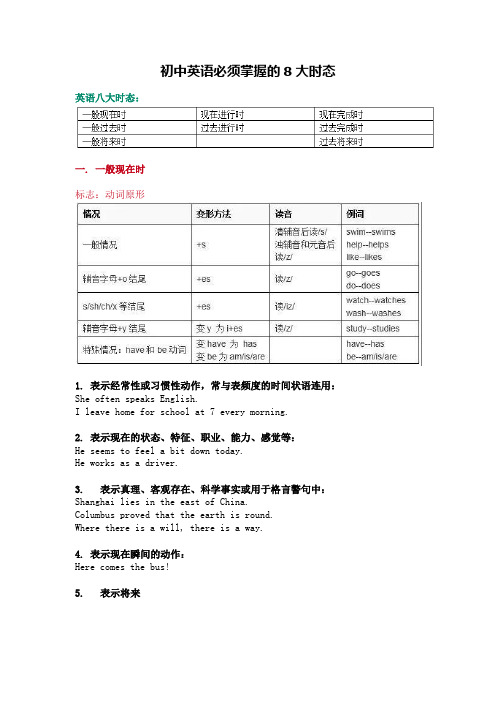
初中英语必须掌握的8大时态英语八大时态:一. 一般现在时标志:动词原形1. 表示经常性或习惯性动作,常与表频度的时间状语连用:She often speaks English.I leave home for school at 7 every morning.2. 表示现在的状态、特征、职业、能力、感觉等:He seems to feel a bit down today.He works as a driver.3. 表示真理、客观存在、科学事实或用于格言警句中:Shanghai lies in the east of China.Columbus proved that the earth is round.Where there is a will, there is a way.4. 表示现在瞬间的动作:Here comes the bus!5. 表示将来1) 表按规定、计划、安排将要发生的动作(仅限于某些表示“来、去、动、停、开始、结束、继续”等的趋向动词),可以与表示未来的时间状语搭配使用。
常见的用法是:飞机、火车、轮船、汽车等定期定点运行的交通状况。
如:The next train leaves at 3 o’clock this afternoon.How often does the shuttle bus run?2) 在时间和条件状语从句中常使用一般现在时表示将来发生的事情:When Bill comes (不用will come), ask him to wait for me.I shall go there tomorrow unless I’m too bus y.二. 一般过去时标志:动词过去式*闭音节:元音字母a, e, i, o, u如果发字母本来的音则称为开音节,否则称为闭音节。
1. 表示过去某时所发生的动作或存在的状态,常与表示过去的时间状语连用(e.g. yesterday, this morning, just now, a moment ago, in May, last night/year / week, once upon a time, the other day, before …,when …, in the past等)。
初中英语必考八大时态结构及用法详解
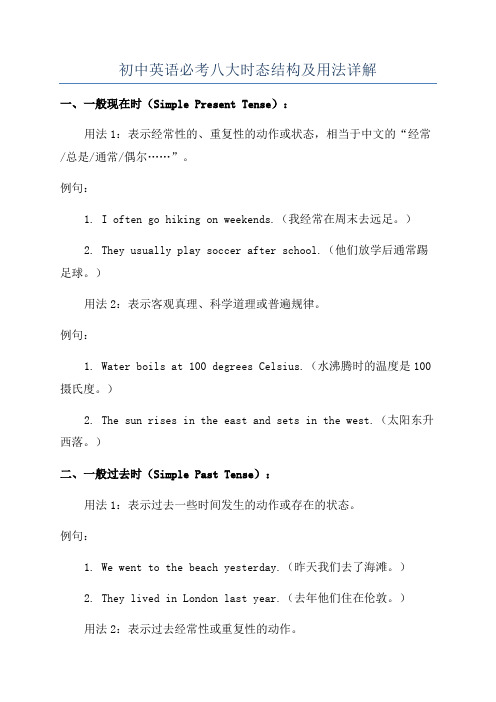
初中英语必考八大时态结构及用法详解一、一般现在时(Simple Present Tense):用法1:表示经常性的、重复性的动作或状态,相当于中文的“经常/总是/通常/偶尔……”。
例句:1. I often go hiking on weekends.(我经常在周末去远足。
)2. They usually play soccer after school.(他们放学后通常踢足球。
)用法2:表示客观真理、科学道理或普遍规律。
例句:1. Water boils at 100 degrees Celsius.(水沸腾时的温度是100摄氏度。
)2. The sun rises in the east and sets in the west.(太阳东升西落。
)二、一般过去时(Simple Past Tense):用法1:表示过去一些时间发生的动作或存在的状态。
例句:1. We went to the beach yesterday.(昨天我们去了海滩。
)2. They lived in London last year.(去年他们住在伦敦。
)用法2:表示过去经常性或重复性的动作。
例句:1. When I was young, I often played hide-and-seek with my friends.(我小时候经常和朋友们玩捉迷藏。
)2. He used to visit his grandparents every summer.(他过去每个夏天都去看望他的祖父母。
)三、一般将来时(Simple Future Tense):用法1:表示将来发生的动作或存在的状态。
例句:1. I will go to the movie tonight.(今晚我将去看电影。
)2. She is going to visit her grandparents next month.(她下个月打算去看望她的祖父母。
人教八年级英语必考八大时态结构及用法详解
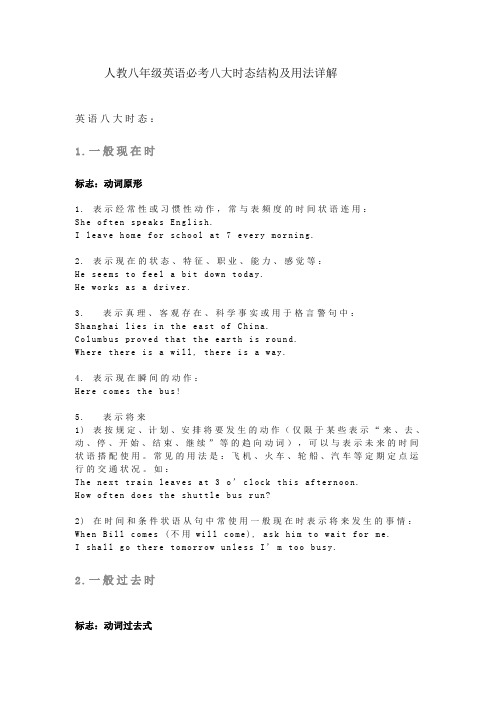
人教八年级英语必考八大时态结构及用法详解英语八大时态:1.一般现在时标志:动词原形1.表示经常性或习惯性动作,常与表频度的时间状语连用:S h e o f t e n s p e a k s E n g l i s h.I l e a v e h o m e f o r s c h o o l a t7e v e r y m o r n i n g.2.表示现在的状态、特征、职业、能力、感觉等:H e s e e m s t o f e e l a b i t d o w n t o d a y.H e w o r k s a s a d r i v e r.3.表示真理、客观存在、科学事实或用于格言警句中:S h a n g h a i l i e s i n t h e e a s t o f C h i n a.C o l u m b u s p r o v e d t h a t t h e e a r t h i s r o u n d.W h e r e t h e r e i s a w i l l,t h e r e i s a w a y.4.表示现在瞬间的动作:H e r e c o m e s t h e b u s!5.表示将来1)表按规定、计划、安排将要发生的动作(仅限于某些表示“来、去、动、停、开始、结束、继续”等的趋向动词),可以与表示未来的时间状语搭配使用。
常见的用法是:飞机、火车、轮船、汽车等定期定点运行的交通状况。
如:T h e n e x t t r a i n l e a v e s a t3o’c l o c k t h i s a f t e r n o o n.H o w o f t e n d o e s t h e s h u t t l e b u s r u n?2)在时间和条件状语从句中常使用一般现在时表示将来发生的事情:W h e n B i l l c o m e s(不用w i l l c o m e),a s k h i m t o w a i t f o r m e.I s h a l l g o t h e r e t o m o r r o w u n l e s s I’m t o o b u s y.2.一般过去时标志:动词过去式*闭音节:元音字母a, e, i, o, u如果发字母本来的音则称为开音节,否则称为闭音节。
初中英语8大时态

表示过去习惯性或经常发生的动作
定义:一般过去时态表示过去某个时间发生的动作或存在的状态强调过去的某个时间点。
用法:通常用于描述过去习惯性或经常发生的动作例如每天早上起床、上学、上班等。
结构:一般过去时态的基本结构是“主语+动词过去式+宾语”例如“I got up t 7 o'clock ever y morning”。
添加标题
用法:将来进行时态常用于表示在将来某个具体时 间点正在发生的动作或行为强调动作的持续性和正 在进行的状态。
添加标题
例子:I will be studying English t 9 o’clock morrow morning. (明天早上9点我正在学习英语。)
表示将来某个时间段内的活动或状态
构成:will/shll + 动词原形
时间状语:morrow, next week, in month等
注意事项:与一般现在时态的 区别和联系
表示将来某个时间点正在进行的动作或行为
添加标题
定义:将来进行时态表示在将来某个时间点正 在进行的动作或行为。
添加标题
结构:将来进行时态的基本结构是“will be + ing”。
定义:将来进行时态表示将来某个时间点正在进行的动作或状态 构成:will be + -ing 用法:表示将来计划好的事情强调动作的持续性 例子:I will be studying English next yer.
表示将来即将发生的动作或安排
添加标题
定义:将来进行时态表示在将来某个时间正在进行的动作或安排。
表示从过去看将来要发生的动作或存在的状态
定义:表示从过 去的某个时间点 看将来某个时间 点之前要发生的 动作或存在的状 态
初中英语语法-八种时态详解
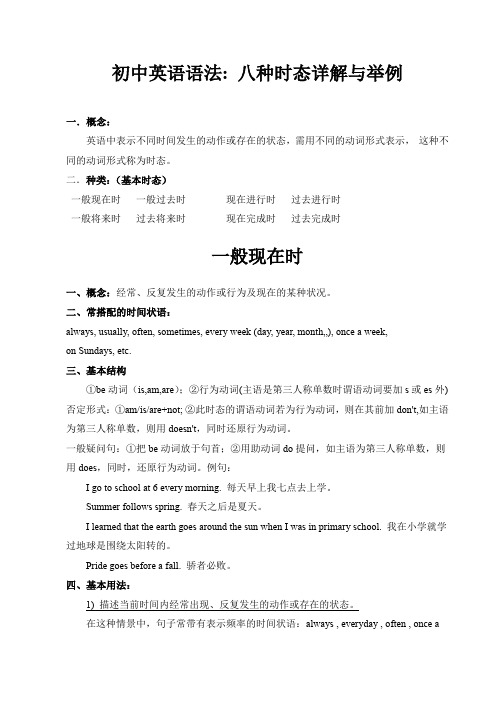
初中英语语法: 八种时态详解与举例一.概念:英语中表示不同时间发生的动作或存在的状态,需用不同的动词形式表示,这种不同的动词形式称为时态。
二.种类:(基本时态)一般现在时一般过去时现在进行时过去进行时一般将来时过去将来时现在完成时过去完成时一般现在时一、概念:经常、反复发生的动作或行为及现在的某种状况。
二、常搭配的时间状语:always, usually, often, sometimes, every wee k (day, year, month…), once a week,on Sundays, etc.三、基本结构①be动词(is,am,are);②行为动词(主语是第三人称单数时谓语动词要加s或es外) 否定形式:①am/is/are+not; ②此时态的谓语动词若为行为动词,则在其前加don't,如主语为第三人称单数,则用doesn't,同时还原行为动词。
一般疑问句:①把be动词放于句首;②用助动词do提问,如主语为第三人称单数,则用does,同时,还原行为动词。
例句:I go to school at 6 every morning. 每天早上我七点去上学。
Summer follows spring. 春天之后是夏天。
I learned that the earth goes around the sun when I was in primary school. 我在小学就学过地球是围绕太阳转的。
Pride goes before a fall. 骄者必败。
四、基本用法:1) 描述当前时间内经常出现、反复发生的动作或存在的状态。
在这种情景中,句子常带有表示频率的时间状语:always , everyday , often , once aweek (month , year , etc.) , sometimes , seldom , usually等等,以表示句中的动作或状态是习惯性的、经常性的。
- 1、下载文档前请自行甄别文档内容的完整性,平台不提供额外的编辑、内容补充、找答案等附加服务。
- 2、"仅部分预览"的文档,不可在线预览部分如存在完整性等问题,可反馈申请退款(可完整预览的文档不适用该条件!)。
- 3、如文档侵犯您的权益,请联系客服反馈,我们会尽快为您处理(人工客服工作时间:9:00-18:30)。
初中8种时态的用法及区别一、一般现在时:概念:经常、反复发生的动作或行为及现在的某种状况。
时间状语: always, usually, often, sometimes, every week (day, year, month…), once a week, etc.基本结构:①主语+be动词+其他;②主语+行为动词 +其他eg:①You are happy. ②She gets up at six every day.否定形式:①am/is/are+not;②此时态的谓语动词若为行为动词,则在其前加don't,如主语为第三人称单数,则用doesn't,同时还原行为动词。
eg:①You are not happy . ②She doesn'tget up at six every day. You一般疑问句:①把be动词放于句首;②用助动词do或者does提问,如主语为第三人称单数,则用does,同时,还原行为动词eg:①Are you hapyy? ② Does she get up at six every day.二、一般过去时:概念:过去某个时间里发生的动作或状态;过去习惯性、经常性的动作、行为。
时间状语:ago, yesterday, the day before yesterday, last week(year, night, month…), in 1989, just now, at the age of 5, one day, long long ago, once upon a time, etc.基本结构:①主语+be动词(过去式)+其他;②主语+行为动词(过去式)+其他 eg:① I was sad last night. ② she went to the shop yesterday否定形式:①was/were+not;②在行为动词前加didn't,同时还原行为动词。
eg:① I was not sad last night. ② she did not go to the shop yesterday一般疑问句:①was或were放于句首;②用助动词do的过去式did 提问,同时还原行为动词。
eg:① Were you sad ?② Did she go to the shop yesterday.三、现在进行时:概念:表示现阶段或说话时正在进行的动作及行为。
时间状语:now, at this time, these days等。
基本结构:主语+ am/is/are+doing +其他 eg:She is playing the guitar now 否定形式:am/is/are+not+doing. She is not playing the guitar now.一般疑问句:把be动词放于句首。
Is she playing the guitar now?四、过去进行时:概念:表示过去某段时间或某一时刻正在发生或进行的行为或动作。
时间状语:at this time yesterday, at that time或以when引导的谓语动词是一般过去时的时间状语等。
基本结构:主语+was/were+doing +其他 She was singing English at five yesterday afternoon.否定形式:was/were + not + doing. She was not singing English at five yesterday afternoon.一般疑问句:把was或were放于句首。
Was she singing English at five yesterday afternoon ?五、现在完成时:概念:过去发生或已经完成的动作对现在造成的影响或结果,或从过去已经开始,持续到现在的动作或状态。
时间状语:recently, lately, since+时间点,for+时间段,in the past few years, etc.基本结构:have/has + done否定形式:have/has + not +done.一般疑问句:have或has。
六、过去完成时:概念:以过去某个时间为标准,在此以前发生的动作或行为,或在过去某动作之前完成的行为,即“过去的过去”。
时间状语:before, by the end of last year(term, month…),etc.基本结构:had + done. 否定形式:had + not + done. 一般疑问句:had放于句首。
七、一般将来时:概念:表示将要发生的动作或存在的状态及打算、计划或准备做某事。
时间状语:tomorrow, next day(week, month, year…),soon, in +一段时间, by…,the day after tomorrow, etc.基本结构:①am/is/are/going to + do;②will/shall + do.否定形式:①was/were + not; ②在行为动词前加didn't,同时还原行为动词。
一般疑问句:①be放于句首;②will/shall提到句首。
八、过去将来时:概念:立足于过去某一时刻,从过去看将来,常用于宾语从句中。
时间状语:the next day(morning, year…),the following month(week…),etc.基本结构:①was/were/going to + do;②would/should + do.否定形式:①was/were/not + going to + do;②would/should + not + do.一般疑问句:①was或were放于句首;②would/should放于句首。
英语的8种时态是整个初中阶段教与学的重点与难点。
为了能有效地掌握英语时态,同学们在学习中必须抓住以下几点:一、记住各种时态的基本用法,是学好时态的关键例如:⑴现在进行时态表示说话时或现阶段正在进行的动作。
(We are learning Lesson3 these days. 表示现阶段这些日子我们正在学习第三课。
)⑵过去进行时态表示过去某时刻正在进行的动作。
(They were Listening to the radio at that time. 表示过去那个时候我们正在听收音机。
)在学习中,用各种时态的基本意义去分析实际问题,就能抓住解决问题的主要矛盾。
二、抓住时间状语的外在标志,是学好时态的捷径1.一般过去时常见的时间状语有:yesterday, the day before yesterday, last night(week...), a moment ago, in the old days等。
2.一般现在时常见的时间状语有:always, often, sometimes, everyday(week...)等。
3.一般将来时常见的时间状语有:soon, next week(month...), in a week(month...)等。
4.过去将来时常见的时间状语有:the next week (month...)等。
5.现在进行时常见的时间状语有:look, now, listen等。
6.过去进行时常见的时间状语有:at that time, + 过去时刻, from ...to... + 过去时间等。
7.现在完成时常见的时间状语有:yet, already, recently, in(during), the last 2 years, since等。
8.过去完成时常见的时间状语有:by the end of, by the end of last year,yesterday...等。
熟练掌握各种时态常见的时间状语标志,可以大大提高应用的效率。
三、注意时态前后一致,是学好时态的一个重要原则例如:He opened the door and came in. (前后都用了一般过去时。
)I’m a student, and I study at a middle school.(前后都用了一般现在时。
)四、注意概括、总结固定模式1.The Future Indefinite Tense + if / when / as soon as / unless + the Present IndefiniteTense(主句用一般将来时,从句用一般现在时表将来时。
)2.The Past Continuous Tense + when + the Past Indefinite Tense (主句用过去进行时,而when引导的从句多用一般过去时表示过去的某一时刻。
)3.The Present Perfect Tense + sincet the Past Indefinite Tense / time(前面用现在完成时,后面用since 引导的一个一般过去时的句子或者一个过去的时间状语。
)在学习过程中,要按照这些模式,反复操练,就能逐步形成技能,把知识变得具体、有形。
五、注意运用比较、鉴别、避免混淆,是学好时态的一个突破口1.in + 2006(2007...)常用于一般过去时,而in +(a week, a month, a minute等)常用于将来时态。
例如:⑴ Tom joined the army in 2006.⑵ He said he would come back in a few days.2.现在完成时和过去完成时都是完成时,但前者是相对现在而言,后者是相对过去而言。
例如:⑴ We’ve learned 1,400 English words.(相对现在来讲)⑵ We had learned 1,400 English words (by yesterday).(相对过去时间来讲。
)3.一般将来时和过去将来时都是将来时,但两者分别是从现在或过去来看将来发生的动作或存在的状态。
例如:⑴ He’ll have his hair cut tomorrow.(从现在某时来看。
)⑵ He said he would have his hair cut the next day.(从过去某时来看。
)4.一般过去时表示过去发生的动作或存在的状态,和现在没有联系;现在完成时表示过去发生的动作或存在的状态对现在造成的影响和结果,和现在有联系。
例如:⑴ He went to town yesterday. (说明进城这个动作昨天已发生,和现在没有联系。
